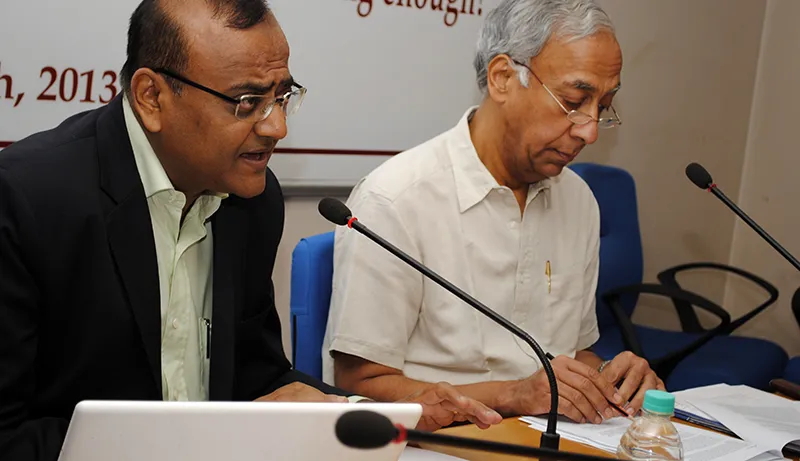At an ORF discussion on advertising regulation on television, while there seemed to be agreement that some regulation is necessary to prevent excessive advertising and harmful or offensive content from airing, the TRAI's notification was badly timed and not adequate to the needs of the industry.

Observer Research Foundation and Hammurabi & Solomon hosted a panel discussion on television advertising regulation, titled ’Finding a Golden Mean: Are 12 Minutes of Advertising Enough?’ on May 8, 2013. Industry stakeholders came together to discuss whether restrictions on advertising minutage could and should be carried out. The Telecom Regulatory Authority of India (TRAI) had issued a notification in May 2012 that advertising should not exceed 12 minutes per an hour of programming. While the 12-minute rule has been in place since the Cable Television Networks Rules 1994, it has not been stringently enforced.
Panellists noted that 12 minutes of advertising is the international norm; it seems likely that broadcasters and advertisers will eventually fall into this pattern. Trying to force conformity through regulations is thus a waste of time and resources. There are greater concerns facing the industry, like the issue of editorial independence. Ownership of news outlets by business conglomerates and politicians has a significant impact on the kind of reporting done. Investigative journalism is cast aside for propaganda and paid news. The question of whether good, ethical journalism could also be profitable was raised. It was suggested that in a mass media consumption market like India, content is created to appeal to the lowest common denominator of viewers. The competitive market has left channels jostling for primetime ratings; many small channels are fighting for survival and so cannot afford to lose advertising revenue.
The timing of the TRAI’s notification was also brought into question. Most of the development in the broadcasting sector has happened in the last ten years, and it is still developing. Digitisation has a ’sunset date’ - by 2015 all of India should be covered. This will allow time for subscription and other revenue streams to pick up, so why not wait until that time?
The underlying rationale behind this regulation and others like it seems to be that advertising is a nuisance and must be controlled. This, however, fails to take into account the many positive aspects of diverse advertising. India’s economy is growing, and every day new businesses, entrepreneurs and brands emerge. Advertising gives them a platform for growth, and thriving businesses will benefit the economy in the long run. At this stage in the country’s development, strangling the advertising industry would be very damaging.
Another doubt raised by the speakers was whether restricting advertising actually improved consumer experience. It has not been established that fewer ads will lead to better content overall. It was acknowledged that too many ads negatively impact the viewing experience and detract from the positive, knowledge-imparting aspects of advertising. However, given the inherent difficulty of trying to objectively judge the quality of ads, any decision to watch or not watch must be left to the viewer. With the vast array of channels, including pay channels without any advertising during programmes, there are many viewing options. If viewers switch channels to avoid advertisements, broadcasters will take notice and reduce the clutter to entice customers back.
While 12 minutes per clock hour is the international average, this does not necessarily indicate that it is the ideal proportion. Studies carried out by advertisers in the USA after World War II determined that between 12 and 14 minutes were needed to advertise thirty products, and so this standard was maintained. Currently, of the 12 minutes permitted for advertising, ten minutes may be commercial advertisements, with the remaining two minutes allocated for self-promotion of the channel. This was criticised, with the consensus being that social messages and channel self-promotions should be exempt from the 12 minute restriction.
The panellists said that India had the lowest ad rates in the world, which are so low because they have been artificially controlled. It cannot be said conclusively that low rates are responsible for excessive advertising, but it does indicate the clout that advertisers wield, especially with smaller channels.
Advertising is more expensive during ’primetime’ hours from 1900 to 2300. During this time, some channels air up to 35 minutes of advertising per hour. It has been argued that as long as the average over 24 hours is less than 12 minutes per hour, it should not be regulated. An alternative is to air programmes without interruptions, then schedule a ’block’ of advertising. This practice was used in the past, but with the rise of new media and unconventional advertising, it is unlikely viewers will sit through long stretches of advertising.
Regulating the minutes of advertising permitted does not take into account advertisements which may be on screen, such as tickers, product placement, player jerseys and the like. This is also a disproportionate attempt to stifle advertising on television. Panellists questioned whether this kind of limitation would be applied to newspapers, for example - restricting the number of square inches ads could take up on any page.
While there seemed to be agreement that some regulation was necessary - to prevent excessive advertising and harmful or offensive content from airing - this notification was badly timed and not adequate to the needs of the industry. As the worldwide average, 12 minutes of advertising in every clock hour is a reasonable goal for the Indian media, but this golden mean should be allowed to develop naturally, not forced through piecemeal regulation.
(This report was prepared by Anahita Mathai, Research Assistant, Observer Research Foundation, Delhi)
The views expressed above belong to the author(s). ORF research and analyses now available on Telegram! Click here to access our curated content — blogs, longforms and interviews.




 PREV
PREV

